Flux Increase Occurring When an Ultrafiltration Membrane Is Flipped from a Normal to an Inverted Position—Experiments and Theory
Abstract
1. Introduction
2. Materials and Methods
2.1. Materials
2.2. Filtration Procedure
2.2.1. PES UF Membrane
- (a)
- Measurement of PWF in the normal position: initially, the membrane coupons were pre-compacted for 1 h by filtering pure water at 70 psig (equivalent to 4.8 bar), followed by a pure water permeation test at 50 psig (3.4 bar) for 4 h.
- (b)
- Measurement of PWF in the inverted position: pre-compaction of new membrane coupons installed in the permeation cells under pure water pressure of 15 psig (1.0 bar) for 1 h, followed by a pure water permeation test at 5 psig (0.34 bar). For the permeation test, the permeate volume, V (L), collected during the period t (h) was measured, and the pure water flux PWF (L/m2·h) of the membrane was calculated bywhere A is the effective membrane area (2.04 × 10−3 m2). The average of the values obtained from the three permeation cells is reported.
- (c)
- UF filtration of a BSA solution in the normal position: pre-compaction of new membrane coupons was conducted with pure water at 70 psig for 1 h in the permeation cells, followed by the filtration experiment with a 100 mg/L BSA solution at 50 psig.
- (d)
- UF filtration of a BSA solution in the inverted position: pre-compaction of new membrane coupons in the permeation cells was conducted by filtering pure water at a pressure of 15 psig for 1 h; this was followed by the filtration experiment with a 100 mg/L BSA solution at 5 psig.
- (e)
- UF filtration of a BSA solution in the normal position: the coupons used in (b) were inverted back to the normal position. PWF was measured, and then a 100 mg/L BSA solution was filtered through them at a pressure of 50 psig. In the BSA filtration test, the permeate flux J was obtained by Equation (1), replacing PWF with J. The BSA concentration in the feed and permeate samples was measured using a UV spectrophotometer (DR6000, Hach Instruments, Loveland, CO, USA) at a wavelength of 220 nm. The solute separation, R, was then calculated by:where Cp and Cf are permeate and feed solute concentrations, respectively.
2.2.2. Ceramic UF Membrane
- (a)
- Testing the ceramic UF membrane in the normal position: the tubular ceramic membrane was first installed and connected to the cross-flow system (membrane effective area: 0.155 m2). The feed water was first delivered to the lumen side of the membrane tubes at a pressure of 2 bar until a stable permeate flux was attained. This normally required 15 min. It was followed by reducing the pressure to 1 bar prior to the collection of the permeate for analysis. Then, the permeate was collected multiple times for a period of 30 min to calculate the permeate flux, and the average permeate flux was then reported.
- (b)
- Testing the ceramic UF membrane in the inverted position: the feed water flowed from the outer surface of the entire tubular ceramic membrane at 2 bar for 15 min in order to achieve flux stabilization. It was followed by reducing the pressure to 1 bar, and the permeate was collected multiple times for a period of 30 min to calculate the average permeate flux. The PWF of the membrane in both orientations was calculated based on Equation (1) as described for the PES UF membrane.
- (c)
- UF of a BSA solution in the normal position: the ceramic membrane (membrane effective area: 0.155 m2) was pre-treated using pure water at 2 bar for 15 min followed by the filtration of a 500 mg/L BSA solution at 1 bar. The permeate flux was recorded every 15 min for up to 60 min to yield an average permeate flux. The fouled membrane was then cleaned by filtering a 1 wt/v% NaOH solution for 30 min.
- (d)
- UF filtration of a BSA solution in the inverted position: the ceramic membrane (membrane effective area: 0.155 m2) was first pre-treated as in (b) at 2 bar for 15 min, followed by filtration of a 500 mg/L BSA solution at 1 bar. The permeate flux was recorded every 15 min for up to 60 min to yield an average permeate flux. The fouled membrane was then washed using a 1 wt/v% NaOH solution for 30 min. An alkaline solution was used because it is normally used to remove organic foulants from a membrane surface. The permeate flux J was calculated using Equation (1) by replacing PWF with J. The BSA concentration in the feed and permeate samples was measured using a UV–vis spectrophotometer (Nicolet iS10, Thermo Scientific, Voltam, MA, USA). The BSA rejection efficiency, R, was then calculated using Equation (2).
- (e)
- UF testing with the PVPK90 solution in normal position and inverted position: the protocol was similar to that for the filtration of a BSA solution, except that the feed solution was replaced by a 250 mg/L PVPK90 solution. The permeate flux J was calculated using Equation (1) by replacing PWF with J. The PVPK90 concentration in the feed and permeate samples was measured using a total organic carbon (TOC) analyzer (OCT-L, Shimadzu, Japan). The PVPK90 rejection efficiency, R, was then calculated using Equation (2).
2.3. Characterization by SEM
3. Results
3.1. Characterization by SEM
3.2. Filtration Experiments
3.2.1. PES UF Membrane
- A two-order-of-magnitude increase in pure water permeance took place when the PES UF membrane was inverted from the normal position.
- Solute (BSA) separation became very low (8.3%) when the membrane was in the inverted position.
- The initial UF performance was recovered when the membrane was flipped back to the normal position.
3.2.2. Ceramic UF Membrane
- For Module 1 experiments, the PWF of the membrane became 1.91 times higher by changing the flow direction from the normal to the inverted position.
- In the normal position, a severe permeance decrease (82%) was observed when a PVPK90 solution was used as the feed, with solute separation of 52%. In the inverted position, the permeance decrease was much less (30%), and there was no solute separation.
4. Discussion
Model Development
5. Conclusions
- (1)
- It was observed that the increase in PWF by flipping the membrane from its normal to an inverted position occurred not only for RO or NF membranes but also for UF membranes.
- (2)
- For the ceramic membrane, whose pore geometry was unchanged by flipping, the increase in PWF was nearly equal to twofold.
- (3)
- The above increase was explained by a mathematical model based on Bernoulli’s law, even though the model could not identify the pore geometry precisely.
- (4)
- For the polymeric PES membrane, the increase was as high as two orders of magnitude. This suggests other reasons for such a large increase, possibly the expansion of the size of the small pores.
- (5)
- The separation of BSA by the PES membrane was above 90% when the membrane was used in the normal position but became less than 10% when the membrane was used in the inverted position.
Supplementary Materials
Author Contributions
Funding
Institutional Review Board Statement
Informed Consent Statement
Data Availability Statement
Conflicts of Interest
References
- Wang, H.; Ding, J.; Dai, L.; Wang, X.; Lin, T. Directional water-transfer through fabrics induced by asymmetric wettability. J. Mater. Chem. 2010, 20, 7938–7940. [Google Scholar] [CrossRef]
- Yang, X.; Yan, L.; Ran, F.; Pal, A.; Long, J.; Shao, L. Interface-confined surface engineering constructing water-unidirectional Janus membrane. J. Membr. Sci. 2019, 576, 9–16. [Google Scholar] [CrossRef]
- Deng, S.; Sourirajan, S.; Matsuura, T. A study of polydimethylsiloxane/aromatic polyamide laminated membranes for separation of acetic acid/water mixtures by pervaporation process. Sep. Sci. Technol. 1994, 29, 1209–1216. [Google Scholar] [CrossRef]
- Mochizuki, A.; Sato, Y.; Ogawara, H.; Tanaka, Y. Behaviors of bi-active layer membrane in pervaporation. Maku Membr. 1984, 9, 279. [Google Scholar] [CrossRef][Green Version]
- Adib, H.; Hassanajili, S.; Mowla, D.; Esmaeilzadeh, F. Fabrication of integrally skinned asymmetric membranes based on nanocomposite polyethersulfone by supercritical CO2 for gas separation. J. Supercrit. Fluids 2015, 97, 6–15. [Google Scholar] [CrossRef]
- Kim, S.G.; Lee, K.H. Poly(vinyl alcohol) membranes having an integrally skinned asymmetric structure. Mol. Cryst. Liq. Cryst. 2009, 512, 32. [Google Scholar] [CrossRef]
- Kim, I.-C.; Yoon, H.-G.; Lee, K.-H. Formation of integrally skinned asymmetric polyetherimide nanofiltration membranes by phase inversion process. J. Appl. Polym. Sci. 2002, 84, 1300–1307. [Google Scholar] [CrossRef]
- Mulder, M. Basic Principles of Membrane Technology, 2nd ed.; Kluwer Academic Publishing: Dordrecht, The Netherlands, 1996; ISBN 978-0-7923-4248-9. [Google Scholar]
- Méricq, J.P.; Mendret, J.; Brosillon, S.; Faur, C. High performance PVDF-TiO2 membranes for water treatment. Chem. Eng. Sci. 2015, 123, 283–291. [Google Scholar] [CrossRef]
- Ahmad, A.L.; Ismail, S.; Bhatia, S. Ultrafiltration behavior in the treatment of agro-industry effluent: Pilot scale studies. Chem. Eng. Sci. 2005, 60, 5385–5394. [Google Scholar] [CrossRef]
- Ferrer, O.; Lefèvre, B.; Prats, G.; Bernat, X.; Gibert, O.; Paraira, M. Reversibility of fouling on ultrafiltration membrane by backwashing and chemical cleaning: Differences in organic fractions behaviour. Desalin. Water Treat. 2016, 57, 8593–8607. [Google Scholar] [CrossRef]
- Chang, H.; Liu, B.; Yang, P.; Wang, Q.; Li, K.; Li, G.; Liang, H. Salt backwashing of organic-fouled ultrafiltration membranes: Effects of feed water properties and hydrodynamic conditions. J. Water Process. Eng. 2019, 30, 100429. [Google Scholar] [CrossRef]
- Membrane Cleaning Technologies. Available online: https://www.lenntech.com/membrane-cleaning.htm (accessed on 14 January 2021).
- Straub, A.P.; Deshmukh, A.; Elimelech, M. Pressure-retarded osmosis for power generation from salinity gradients: Is it viable? Energy Environ. Sci. 2016, 9, 31–48. [Google Scholar] [CrossRef]
- Han, G.; Zhang, S.; Li, X.; Chung, T.-S. Progress in pressure retarded osmosis (PRO) membranes for osmotic power generation. Prog. Polym. Sci. 2015, 51, 1–27. [Google Scholar] [CrossRef]
- Lau, W.-J.; Lai, G.-S.; Li, J.; Gray, S.; Hu, Y.; Misdan, N.; Goh, P.-S.; Matsuura, T.; Azelee, I.W.; Ismail, A.F. Development of microporous substrates of polyamide thin film composite membranes for pressure-driven and osmotically-driven membrane processes: A review. J. Ind. Eng. Chem. 2019, 77, 25–59. [Google Scholar] [CrossRef]
- Sourirajan, L. Reverse Osmosis. 1970. Available online: https://www.abebooks.com/servlet/BookDetailsPL?bi=13397851390&searchurl=an%3Dsourirajan%26sortby%3D17%26tn%3Dreverse%2Bosmosis&cm_sp=snippet-_-srp1-_-title2 (accessed on 1 March 2020).
- Khoo, Y.S.; Lau, W.J.; Chamani, H.; Matsuura, T.; Ismail, A.F. Water flux increase by inverting the membrane from its normal position—Is it occurring in FO and PRO? J. Water Process. Eng. 2020, 37, 101366. [Google Scholar] [CrossRef]
- Mosqueda-Jimenez, D.B.; Narbaitz, R.M.; Matsuura, T. Membrane Fouling Test: Apparatus Evaluation. J. Environ. Eng. 2004, 130, 90–99. [Google Scholar] [CrossRef]
- Zoka, L.; Narbaitz, R.M.; Matsuura, T. Effect of Surface Modification with Electrospun Nanofibers on the Performance of an Ultrafiltration Membrane Article info. J. Membr. Sci. Res. 2020, 6, 351–358. [Google Scholar] [CrossRef]
- Wei, S.; Hossain, M.M.; Saleh, Z.S. Concentration of Rutin Model Solutions from Their Mixtures with Glucose Using Ultrafiltration. Int. J. Mol. Sci. 2010, 11, 672–690. [Google Scholar] [CrossRef] [PubMed]
- Liang, S.; Qi, G.; Xiao, K.; Sun, J.; Giannelis, E.P.; Huang, X.; Elimelech, M. Organic fouling behavior of superhydrophilic polyvinylidene fluoride (PVDF) ultrafiltration membranes functionalized with surface-tailored nanoparticles: Implications for organic fouling in membrane bioreactors. J. Membr. Sci. 2014, 463, 94–101. [Google Scholar] [CrossRef]

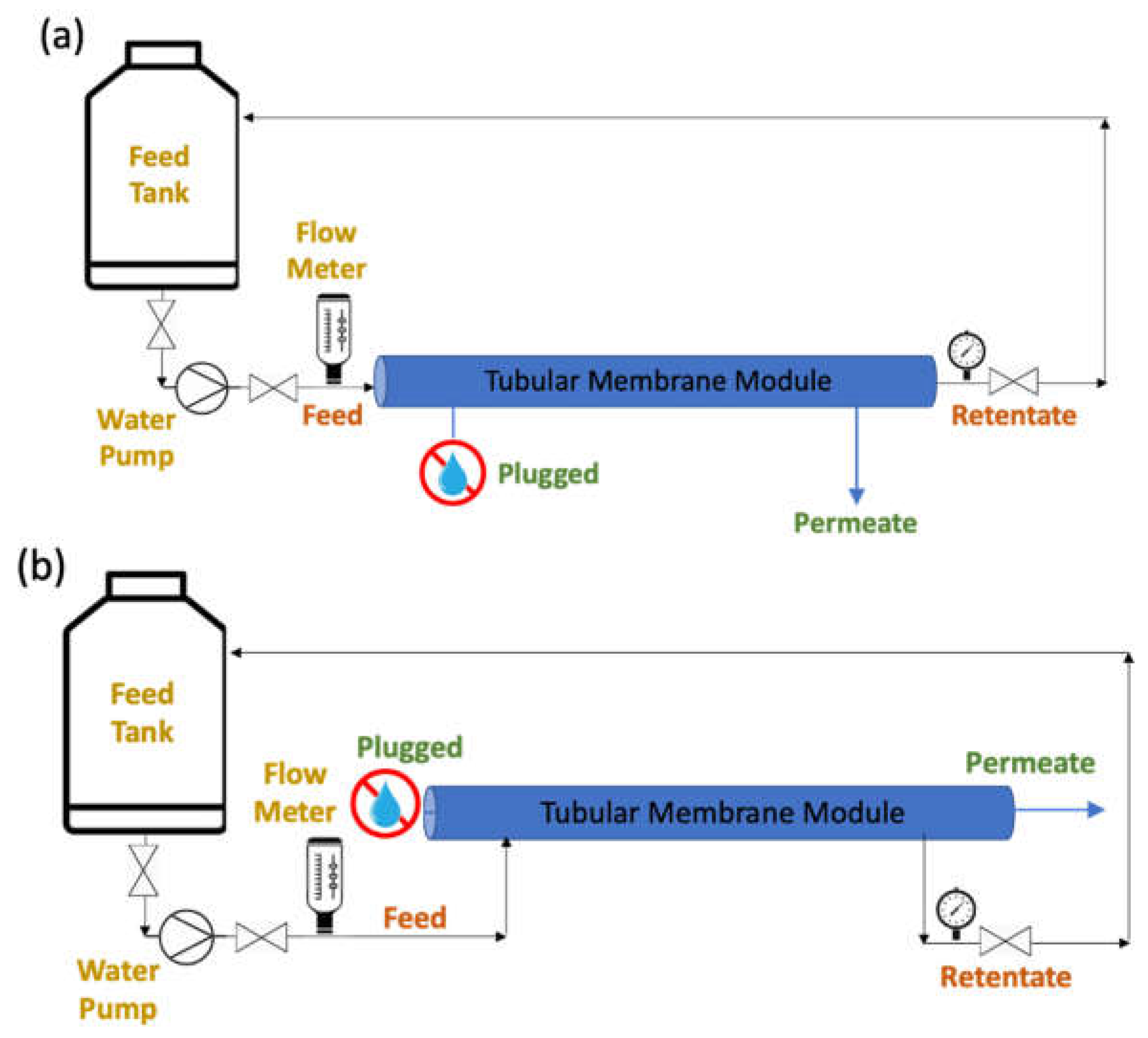
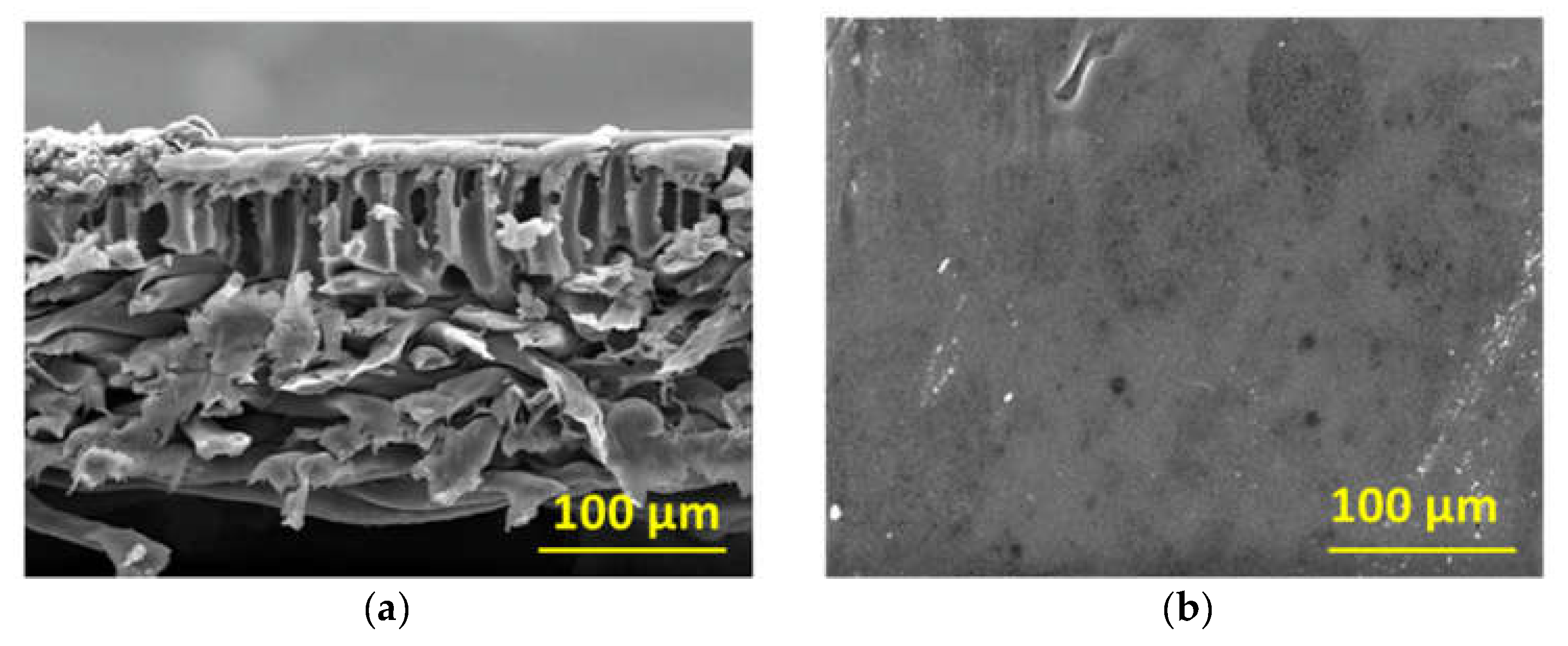
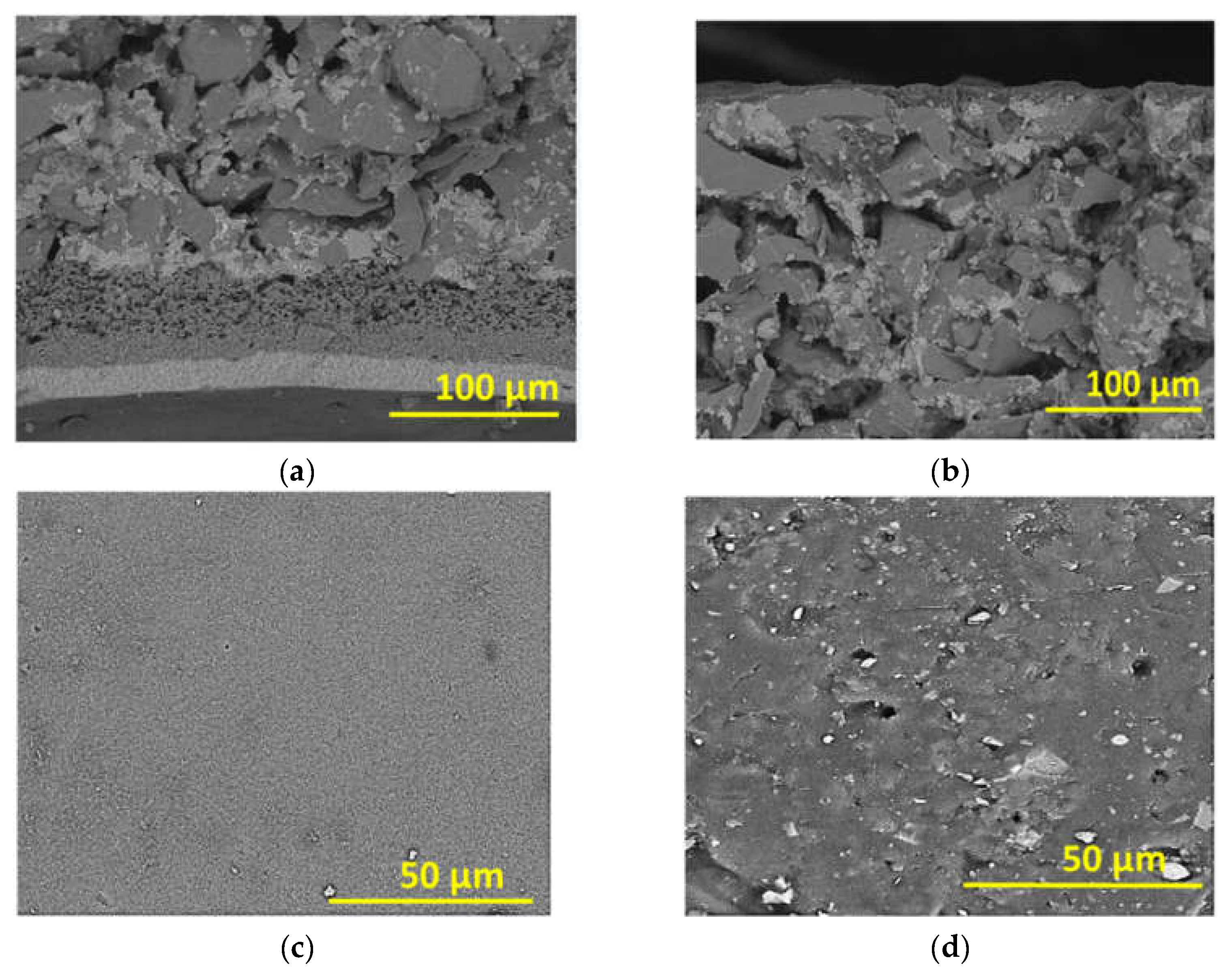
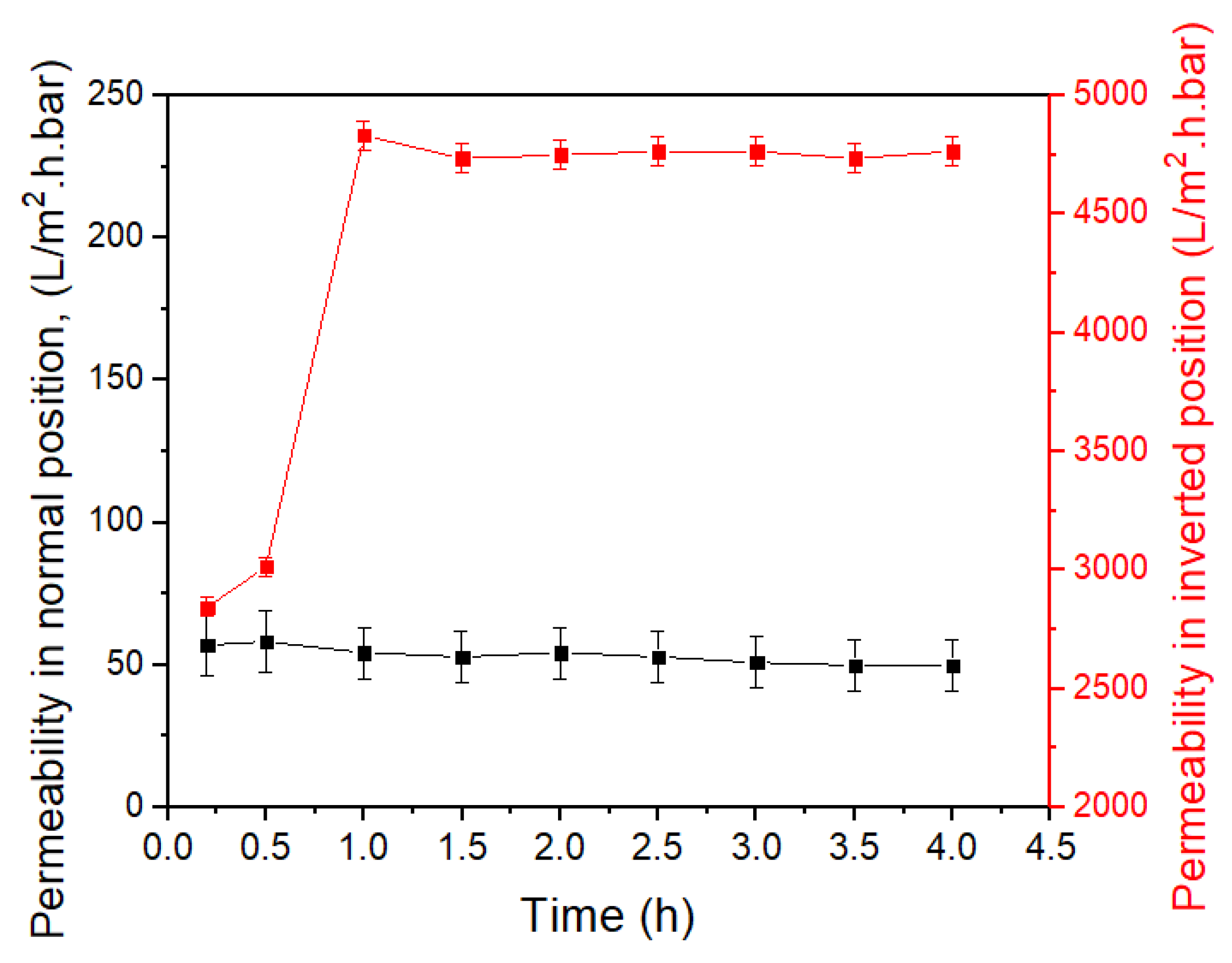
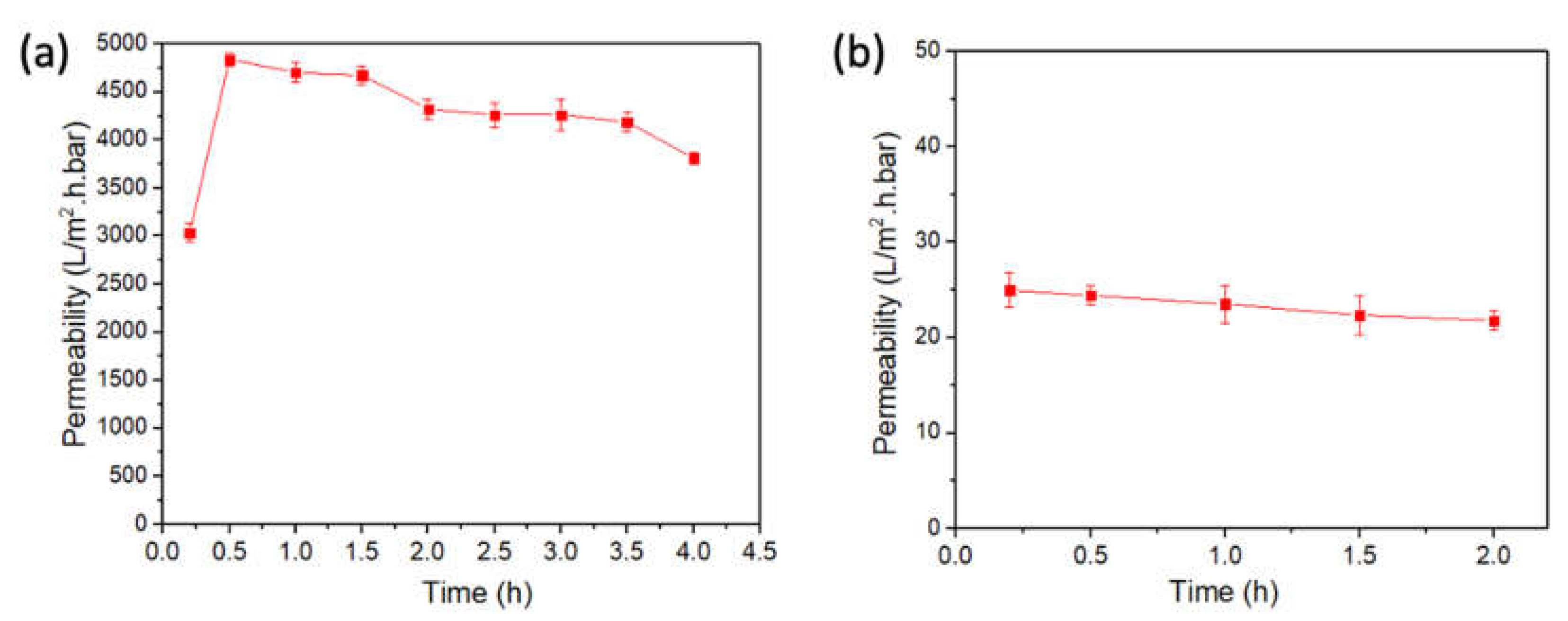
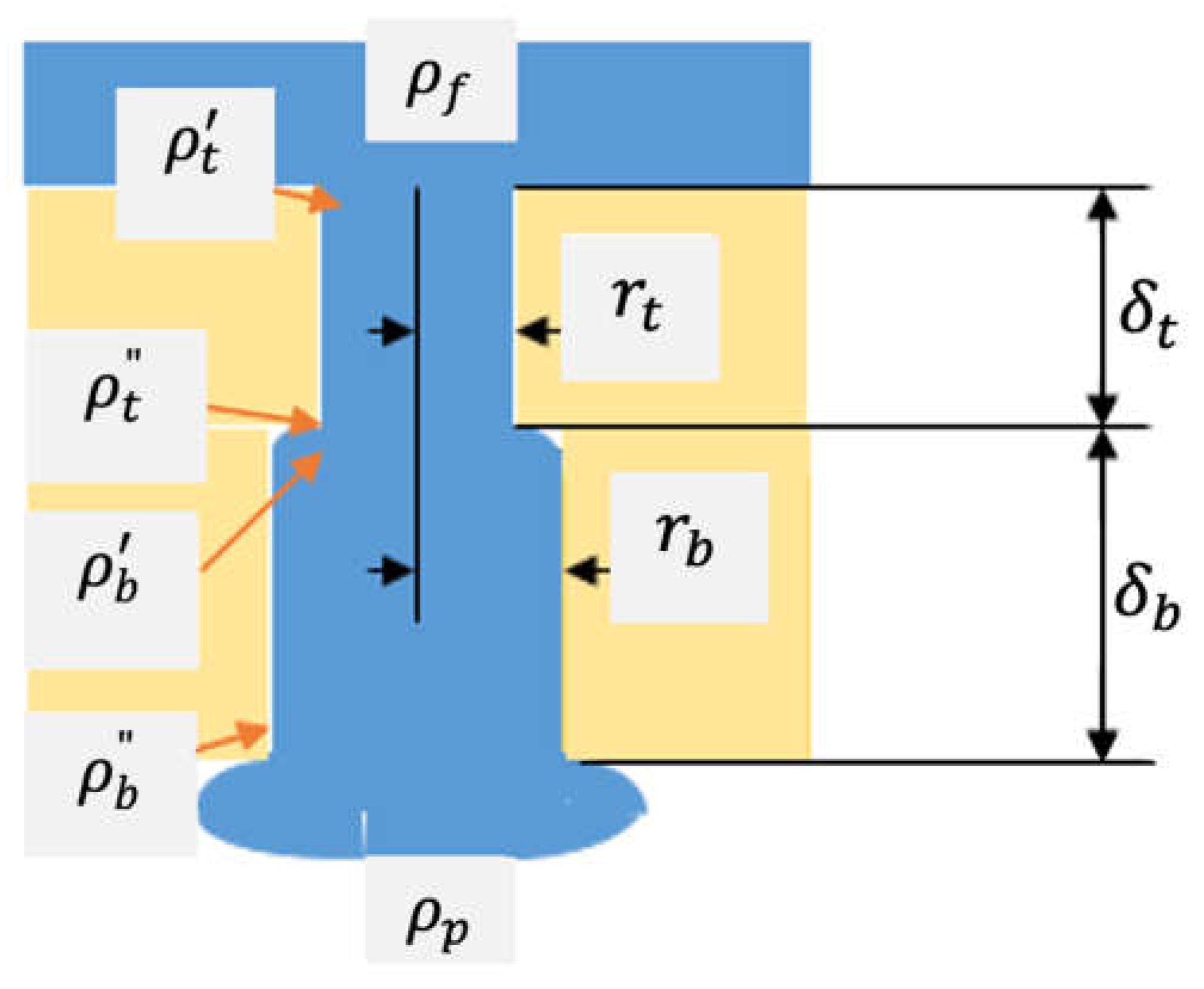
| Position | Feed | Permeance a (L/m2·h·bar) | Separation (%) |
|---|---|---|---|
| Module 1 | |||
| Normal position | Pure water | 327.8 ± 4.5 | - |
| Inverted position | Pure water | 626.3 ± 10.9 | - |
| Normal position | PVPK90 (250 ppm) | 57.3 ± 7.6 | 52.0 |
| Inverted position | PVPK90 (250 ppm) | 437.6 ± 12.2 | 0 |
| Module 2 | |||
| Normal position | Pure water | 580 ± 10.3 | - |
| Normal position | BSA (500 ppm) | 490 ± 19.5 | 40.0 |
| Normal position after cleaning with 1 wt% NaOH solution | Pure water | 522 ± 10.1 | - |
| Normal position after cleaning with 1 wt% NaOH solution | PVPK90 (250 ppm) | - | 52.0 |
| Normal position after another cleaning with 1 wt% NaOH solution | Pure water | 68.9 ± 1.1 | - |
| Normal position after further backwashing with 1 wt% NaOH solution | Pure water | 406 ± 3.0 | - |
Publisher’s Note: MDPI stays neutral with regard to jurisdictional claims in published maps and institutional affiliations. |
© 2022 by the authors. Licensee MDPI, Basel, Switzerland. This article is an open access article distributed under the terms and conditions of the Creative Commons Attribution (CC BY) license (https://creativecommons.org/licenses/by/4.0/).
Share and Cite
Zoka, L.; Khoo, Y.S.; Lau, W.J.; Matsuura, T.; Narbaitz, R.; Ismail, A.F. Flux Increase Occurring When an Ultrafiltration Membrane Is Flipped from a Normal to an Inverted Position—Experiments and Theory. Membranes 2022, 12, 129. https://doi.org/10.3390/membranes12020129
Zoka L, Khoo YS, Lau WJ, Matsuura T, Narbaitz R, Ismail AF. Flux Increase Occurring When an Ultrafiltration Membrane Is Flipped from a Normal to an Inverted Position—Experiments and Theory. Membranes. 2022; 12(2):129. https://doi.org/10.3390/membranes12020129
Chicago/Turabian StyleZoka, Ladan, Ying Siew Khoo, Woei Jye Lau, Takeshi Matsuura, Roberto Narbaitz, and Ahmad Fauzi Ismail. 2022. "Flux Increase Occurring When an Ultrafiltration Membrane Is Flipped from a Normal to an Inverted Position—Experiments and Theory" Membranes 12, no. 2: 129. https://doi.org/10.3390/membranes12020129
APA StyleZoka, L., Khoo, Y. S., Lau, W. J., Matsuura, T., Narbaitz, R., & Ismail, A. F. (2022). Flux Increase Occurring When an Ultrafiltration Membrane Is Flipped from a Normal to an Inverted Position—Experiments and Theory. Membranes, 12(2), 129. https://doi.org/10.3390/membranes12020129








